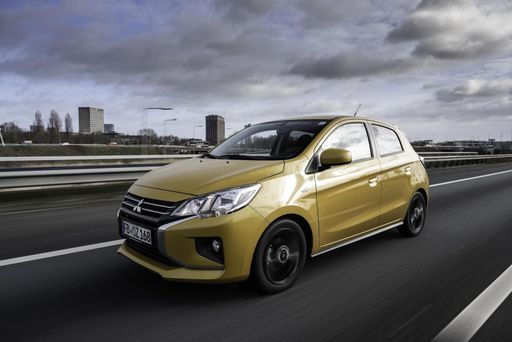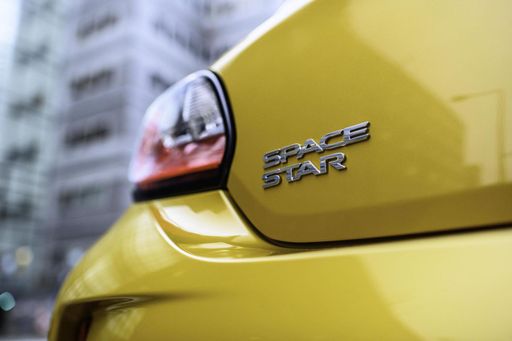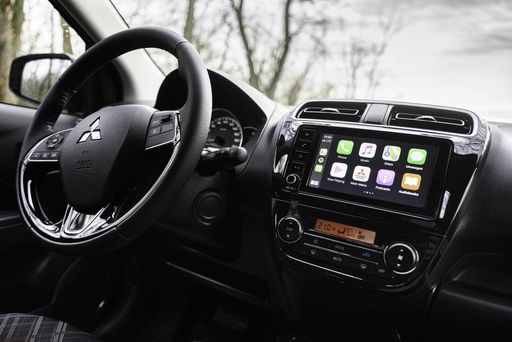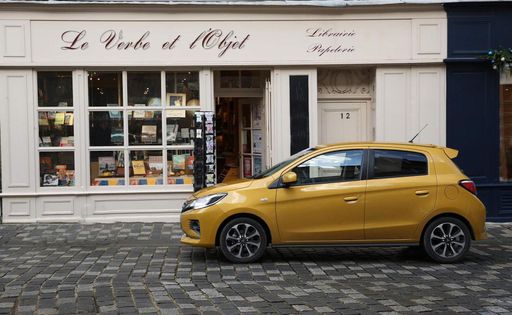Toyota Yaris vs Mitsubishi Space Star – Technische Daten, Verbrauch & Preise im Vergleich
Welches Modell überzeugt mehr – der Toyota Yaris oder der Mitsubishi Space Star?
Wir vergleichen für dich Leistung (280 PS vs 71 PS), Kofferraumvolumen (286 L vs 235 L), Verbrauch (3.80 L vs 4.90 L) und natürlich den Preis (23900 Fr. vs 12700 Fr.).
Finde jetzt heraus, welches Auto besser zu dir passt!
Der Toyota Yaris (Schrägheck) wird mit einem Voll Hybrid oder Benzin-Motor angetrieben und ist mit einem Automatik oder Manuel Getriebe ausgestattet. Im Vergleich dazu hat der Mitsubishi Space Star (Schrägheck) einen Benzin-Motor und ein Manuel oder Automatik Getriebe.
In Sachen Kofferraumvolumen bietet dir der 286 L beim Toyota Yaris bzw. 235 L beim Mitsubishi Space Star ausreichend Platz – je nachdem, worauf du Wert legst. Wer mehr Leistung sucht, muss wählen ob die 280 PS des Toyota Yaris oder die 71 PS des Mitsubishi Space Star für die eigenen Bedürfnisse genügen.
Auch beim Verbrauch unterscheiden sich die beiden Modelle: 3.80 L vs 4.90 L. Preislich liegt der Toyota Yaris bei 23900 Fr., während der Mitsubishi Space Star bei 12700 Fr. zu haben ist.
Vergleiche alle Daten direkt und finde heraus, welches Modell zu deinem Lifestyle passt!
The Mitsubishi Space Star, known for its spacious interior and fuel efficiency, caters well to urban drivers seeking practicality without sacrificing comfort. On the other hand, the Toyota Yaris stands out with its dynamic handling and advanced safety features, appealing to those who prioritize a spirited driving experience. Both models present compelling options in the compact car segment, with the Space Star excelling in value for everyday use and the Yaris offering a lively performance for agile city navigation.
Toyota Yaris
The Toyota Yaris exudes a charming blend of practicality and style, making it an appealing choice for urban drivers. Its compact design allows for easy manoeuvrability in crowded city streets, while the interior offers a surprisingly spacious and comfortable environment. With a focus on fuel efficiency and reliability, the Yaris remains a popular option for those seeking a balance between performance and economy.
Details @ Toyota
@ Toyota
 @ Toyota
@ Toyota
Mitsubishi Space Star
The Mitsubishi Space Star offers a compact yet surprisingly spacious experience, making it an ideal choice for urban dwellers who need agility and comfort. Its sleek design is complemented by a range of vibrant colour options, adding a touch of flair to everyday commutes. With a focus on efficiency and practicality, the Space Star combines a user-friendly interface with modern technology to ensure a smooth driving experience.
Details @ presse.mitsubishi-motors.de
@ presse.mitsubishi-motors.de
 @ presse.mitsubishi-motors.de
@ presse.mitsubishi-motors.de
 @ presse.mitsubishi-motors.de
@ presse.mitsubishi-motors.de
 @ presse.mitsubishi-motors.de
@ presse.mitsubishi-motors.de
A Hatchback Duel: Mitsubishi Space Star vs Toyota Yaris
In the world of compact hatchbacks, two models consistently stand out from the crowd: the Mitsubishi Space Star and the Toyota Yaris. Both vehicles are known for their urban-friendly design, fuel efficiency, and compact dimensions, but how do they stack up against each other in a detailed comparison?
Design and Dimensions
The Space Star and the Yaris are designed for maneuverability in tight urban environments. The Mitsubishi Space Star stretches to a length of 3845 mm, with a width of 1665 mm and a height of 1505 mm, making it an ideal candidate for city driving. The Toyota Yaris, slightly larger, measures between 3940 mm and 3995 mm in length, with a width ranging from 1745 mm to 1805 mm, and a height of 1500 mm to 1455 mm. This subtle increase in size for the Yaris affords it a sturdier road presence.
Engine and Performance
The Mitsubishi Space Star offers a simple yet effective setup with a 1.2L petrol engine, producing 71 HP and a torque of 102 Nm. This three-cylinder engine supports a manual gearbox or a CVT automatic transmission, promising an average fuel consumption of around 5 L/100km. While not the quickest with a 0-100km/h time of 14.1 to 15.8 seconds, its modest curb weight ranging between 940 and 1009 kg helps it maintain decent agility for everyday needs.
On the other hand, the Toyota Yaris offers a more extensive engine lineup, including both petrol and full hybrid configurations. The Yaris offers more power, with horsepower ranging from 116 to 130 HP and up to 280 HP on the sportier models. This is paired with a torque output as high as 390 Nm, promising an exhilarating drive with 0-100km/h acceleration times between 5.5 and 9.7 seconds. Its hybrid variant impressively achieves an average consumption of just 3.8 L/100km, setting a high benchmark for efficiency.
Technology and Features
In terms of technology, both models boast a suite of features designed to enhance the driving experience. The Space Star is equipped with essentials like a 5-seat configuration, delivering practicality in a straightforward package. On the other hand, the Toyota Yaris includes a range of advanced features, with potential all-wheel drive options and a full suite of safety technologies, highlighting its appeal to tech-savvy buyers and families alike.
Environmental Impact
When considering environmental impact, the Yaris again takes the lead with its full hybrid model emitting as little as 87g/km in CO2, comfortably fitting within efficiency class B. The Space Star, while efficient for its class with emissions between 112 and 125g/km, sits within classes C and D. These figures make the Yaris a more appealing option for eco-conscious drivers who prioritize reducing their carbon footprint.
Cargo and Practicality
Both hatchbacks offer practical cargo spaces, though the Toyota Yaris pulls ahead with a trunk capacity of up to 286 liters, compared to the Space Star’s 235 to 209 liters. The Yaris’ additional payload capacity of up to 525 kg also enhances its versatility for daily transport tasks.
Conclusion: Which Hatchback Reigns Supreme?
The Mitsubishi Space Star and the Toyota Yaris both shine in the hatchback arena, each offering unique strengths. The Space Star’s affordable simplicity and practicality make it an ideal choice for drivers prioritizing straightforward functionality. However, for those seeking advanced tech, stronger performance, and superior efficiency, the Toyota Yaris edges ahead, particularly with its hybrid powertrain options.
Ultimately, the choice between the Space Star and the Yaris hinges on priorities: budget and basic functionality, or advanced features and higher efficiency. Both vehicles deliver on their promises, solidifying their positions as leaders in the compact hatchback market.

|

|
|
|
|
Kosten und Verbrauch |
|
|---|---|
|
Preis
23900 - 54500 Fr.
|
Preis
12700 - 20700 Fr.
|
|
Verbrauch L/100km
3.8 - 9.5 L
|
Verbrauch L/100km
4.9 - 5.5 L
|
|
Verbrauch kWh/100km
-
|
Verbrauch kWh/100km
-
|
|
Elektrische Reichweite
-
|
Elektrische Reichweite
-
|
|
Batteriekapazität
-
|
Batteriekapazität
-
|
|
co2
87 - 215 g/km
|
co2
112 - 125 g/km
|
|
Tankgröße
36 - 50 L
|
Tankgröße
35 L
|
Maße und Karosserie |
|
|---|---|
|
Karosserie
Schrägheck
|
Karosserie
Schrägheck
|
|
Sitze
4 - 5
|
Sitze
5
|
|
Türen
3 - 5
|
Türen
5
|
|
Leergewicht
1090 - 1356 kg
|
Leergewicht
940 - 1009 kg
|
|
Kofferraum
141 - 286 L
|
Kofferraum
209 - 235 L
|
|
Länge
3940 - 3995 mm
|
Länge
3845 mm
|
|
Breite
1745 - 1805 mm
|
Breite
1665 mm
|
|
Höhe
1455 - 1500 mm
|
Höhe
1505 mm
|
|
Zuladung
289 - 525 kg
|
Zuladung
360 - 400 kg
|
Motor und Leistung |
|
|---|---|
|
Motorart
Voll Hybrid, Benzin
|
Motorart
Benzin
|
|
Getriebe
Automatik, Manuel
|
Getriebe
Manuel, Automatik
|
|
Getriebe Detail
Schaltgetriebe, Automatikgetriebe
|
Getriebe Detail
Schaltgetriebe
|
|
Antriebsart
Frontantrieb, Allrad
|
Antriebsart
Frontantrieb
|
|
Leistung PS
116 - 280 PS
|
Leistung PS
71 PS
|
|
Beschleunigung 0-100km/h
5.5 - 9.7 s
|
Beschleunigung 0-100km/h
14.1 - 15.8 s
|
|
max. Geschwindigkeit
175 - 230 km/h
|
max. Geschwindigkeit
163 - 167 km/h
|
|
Drehmoment
390 Nm
|
Drehmoment
102 Nm
|
|
Anzahl Zylinder
3
|
Anzahl Zylinder
3
|
|
Leistung kW
85 - 206 kW
|
Leistung kW
52 kW
|
|
Hubraum
1490 - 1618 cm3
|
Hubraum
1193 cm3
|
Allgemein |
|
|---|---|
|
Modelljahr
2024 - 2025
|
Modelljahr
2020 - 2023
|
|
CO2-Effizienzklasse
B, G
|
CO2-Effizienzklasse
C, D
|
|
Marke
Toyota
|
Marke
Mitsubishi
|
Toyota Yaris
Introducing the Next-Gen Toyota Yaris: A Blend of Innovation and Technology
The Toyota Yaris has long been lauded for its efficiency, reliability, and practicality. As we venture into the 2024 model year, Toyota has upped the ante with the latest versions of this popular hatchback, melding cutting-edge technology with eco-conscious design. Here’s an in-depth look at what makes the current Yaris line-up stand out from the crowd.
Efficient Powertrains: Hybrid and Beyond
Spearheading the technological innovation in the Yaris range is the introduction of various hybrid models. The Yaris offers a 1.5-litre full-hybrid engine, marrying a petrol engine with an electric motor to produce between 116 and 130 PS. This power blend is controlled via a sophisticated CVT-gearbox, optimizing both performance and fuel efficiency, with consumption figures ranging from an impressive 3.8 to 4.2 litres per 100 km.
For those seeking pure performance, the GR Yaris variants provide a turbocharged 1.6-litre engine capable of producing 280 PS. This power is delivered via a choice of manual or automatic transmission, giving drivers the tactile involvement or convenience they desire.
Design that Fulfils and Inspires
The Yaris hasn't forgotten its roots as a compact, city-friendly hatchback, measuring between 3,940 and 3,995 mm in length. With its bold front grille, sleek lines, and a choice of striking colours, it's a car that turns heads while remaining perfectly suited for urban environments.
The interior is equally impressive, designed with a focus on driver convenience and comfort. Depending on the variant, Yaris can offer generous cargo space of up to 286 litres, making it a perfect companion for everyday tasks or weekend escapes.
Technological Integration: The Smart Choice
Toyota's approach goes beyond just improving engine technology; the Yaris is packed with innovative features aimed at enhancing the driving experience. It boasts a suite of advanced safety systems such as lane departure alert, pre-collision system, and adaptive cruise control, ensuring peace of mind on the road.
The infotainment system in the Yaris is designed to keep you connected, offering seamless smartphone integration, a user-friendly interface, and an intuitive navigation system, ensuring that you're always informed and entertained.
The Cost of Innovation
Owning a Yaris is not just about impressive technology; it's also about making economic sense. With a price range between €25,500 and €49,990, and monthly costs spanning from €748 to €1,513, it offers a broad spectrum to suit different budget needs.
Concerned about emissions? You can rest easy knowing that the Yaris boasts a CO2 efficiency class ranging from B to G, thanks to its low emissions output of between 87 to 215 g/km.
Conclusion: The Toyota Yaris Drives the Future
The Toyota Yaris continues to be a strong contender in the compact car segment, pushing boundaries with its innovative full-hybrid systems and performance-oriented GR models. It's a remarkable blend of design, technology, and economy, ensuring it remains a top choice for drivers who demand more from their hatchbacks.
Whether you're seeking the efficiency of a hybrid or the thrill of the GR Yaris, there's a model tailored to your unique driving needs in Toyota's latest Yaris lineup.
Mitsubishi Space Star
Introducing the Mitsubishi Space Star: A Perfect Blend of Efficiency and Innovation
The Mitsubishi Space Star continues to impress urban drivers with its compact yet efficient design. Celebrated for its practicality and fuel economy, this hatchback offers a unique blend of new-age technology and reliable performance. Let’s dive into some of the technical details and innovations that make the Space Star a popular choice among compact car enthusiasts.
Engine and Performance
The Space Star is powered by a 1.2-litre, 3-cylinder petrol engine, delivering a respectable 71 PS (52 kW). The engine provides a harmonious balance of power and efficiency, reaching a top speed of up to 167 km/h. With a torque of 102 Nm, drivers can expect smooth city rides and decent highway cruising capabilities. The Space Star's economy ranges from 4.9 to 5.5 litres per 100 kilometres, ensuring that your journeys remain budget-friendly and environmentally considerate.
Transmission and Driving Dynamics
When it comes to the driving experience, buyers have the option of a 5-speed manual transmission or a CVT automatic. This flexibility allows for a more personalised driving experience, whether you prefer the engagement of manual shifting or the convenience of an automatic gearbox. The car's front-wheel-drive setup further enhances its maneuverability, making it an ideal companion for navigating tight city streets.
Design and Dimensions
The Mitsubishi Space Star is designed to turn heads with its sleek, aerodynamic lines while maintaining a practical size. Measuring 3845 mm in length, 1665 mm in width, and 1505 mm in height, it's a perfect fit for urban driving. Despite its compact form, the Space Star offers five seats and five doors, providing ample accessibility and comfort for both the driver and passengers.
Interior Features and Comfort
Inside, the Space Star prioritises comfort and convenience with thoughtfully designed interiors. The luggage space ranges from 209 to 235 litres, ideal for shopping trips or weekend getaways. The vehicle comes in a variety of trim levels, including Basis, Plus, Select, and Top, with each offering distinct features to meet different customer needs. Whether you need basic amenities or more premium touches, the Space Star has a version that will suit your lifestyle.
Safety and Environmental Impact
Safety innovation is a hallmark of the Mitsubishi Space Star, ensuring peace of mind for drivers and passengers alike. Its CO2 efficiency class ranges from C to D, with emissions between 112 to 125 g/km, reflecting its dedication to reducing the environmental footprint. These features contribute to making the Space Star a responsible choice for the eco-conscious driver.
Cost of Ownership
Affordability is another attractive aspect of the Space Star. Prices range from €13,590 to €21,790, making it accessible for a wide array of budgets. Running costs are equally competitive, with monthly expenses estimated between €627 and €767, and cost per kilometre ranging from 25.1 to 30.7 cents, all contributing to a car that is as economical to own as it is to drive.
Conclusion
In summary, the Mitsubishi Space Star offers a compelling package of efficiency, practicality, and modern technology. Its combination of fuel economy, flexible transmission options, and affordability make it a standout choice in the compact car segment. For those looking for a reliable and economical city car, the Space Star remains a strong contender that shouldn't be overlooked.
Die angezeigten Preise und Daten sind Schätzungen, die auf deutschen Listenpreisen basieren, und können je nach Land variieren. Diese Informationen sind rechtlich nicht bindend.
